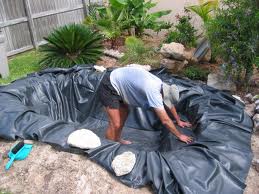





A pond liner is a flexible waterproof membrane that covers the sides and floor of a pond excavation. There are several different kinds to choose from, each with different properties and being suitable for a variety of purposes and budgets.
 Although polythene pond liners are available for the home gardener, there is little to recommend them apart from their low cost. Often coloured bright blue, they have a very short life and are difficult to install. A polythene pond liner must he moulded to the shape of the pond before water is added, making it almost impossible to install without producing masses of wrinkles. The material is also degraded by ultraviolet light, and any unprotected parts of the liner, notably between the surface of the water and the surrounding ground, are likely to deteriorate, crack and leak.
Although polythene pond liners are available for the home gardener, there is little to recommend them apart from their low cost. Often coloured bright blue, they have a very short life and are difficult to install. A polythene pond liner must he moulded to the shape of the pond before water is added, making it almost impossible to install without producing masses of wrinkles. The material is also degraded by ultraviolet light, and any unprotected parts of the liner, notably between the surface of the water and the surrounding ground, are likely to deteriorate, crack and leak.
Polythene is only useful in water garden construction as the filling of a sandwich in a naturally managed pond. In this case, the excavation is made larger than finally required, then it is lined with the polythene. Finally, the liner is covered completely with soil, which prevents any degradation by sunlight. Under such circumstances, wrinkles and creases are of no consequence.
These are traditional liners that have a similar appearance to polythene, but are much more resilient. They have a degree of elasticity that permits them to mould readily to an excavation when water is added, and they have a much greater burst resistance than polythene. This is often enhanced by a terylene web that is incorporated into the liner, giving it a rougher bumpy feel. If you are into bright blue, sea green or pebble-pattern liners, the PVC manufacturers can usually oblige. With a life that is usually guaranteed for a minimum of ten years, PVC is a good buy, but it has largely been overtaken by the more modern low-density polyethylene (LDPE).
Low-density polyethylene liners offer an economical alternative to PVC. Invariably, they are black, but they have enormous flexibility compared with PVC, giving a much neater finish to the pond. They form to the contours of an excavation more snugly and rarely produce significant wrinkles if folded boldly at the corners.
Rubber liners have long been regarded as the best method of pond construction, offering versatility with durability. However, they are quite expensive. Unlike other forms of pond liner, rubber can be welded satisfactorily into almost any size and configuration. It can also be repaired without serious difficulty.
A rubber liner exhibits the same flexibility as an LDPE type and can be installed with the minimum of creases. It is said to have a life of more than 25 years, and provided you do not accidentally push a garden fork through it, this is likely to be the case. Unlike other lining materials, rubber does not have a shiny finish, which means that it rapidly becomes covered in the pond’s micro-flora and blends quickly into the background.
Most ponds can be constructed from most liners, but in some circumstances one will offer particular advantages over another. Otherwise, the choice is likely to depend on cost, and in most cases, it is wise to buy the best you can afford.
Where no part of the liner is exposed, polythene is perfectly adequate. It is not always necessary to employ a proprietary polythene pond liner either; ordinary builders’ polythene, such as that used as a damp-proof membrane beneath concrete, is perfectly adequate.
If a much tougher material is required, a stack or truck load cover can be used. These are exceptionally tough and are ideal if they are to be covered completely with soil. They have ring eyelets around the edges, allowing them to be secured easily with pegs or large metal staples if required.
Rubber liners are better where exposure is inevitable, especially in formal water features that have limited planting because the water itself is the main attraction, perhaps as a reflecting pond or a turbulent fountain. Not all pond owners are enthusiastic gardeners; many have water for its own sake. Similarly, in formal situations where a fitted liner is desirable, it is more practical to use rubber, as this can be welded to the shape with accurate corners and curves. Indeed, with a square, oblong or circular pond, a rubber liner can be manufactured precisely to the correct shape, thus avoiding wrinkles or folds.
Never buy a liner and attempt to dig a hole to accommodate it; always finish the excavation first and calculate the size to fit. Irrespective of the pond’s shape or configuration, calculating liner size follows a simple formula: take the length and add twice the maximum depth, then do the same with the width. This will provide a liner that will suit the excavation and have sufficient overlap at the edges for a satisfactory finish, but with the minimum of wastage.
Copyright © www.100flowers.win Botanic Garden All Rights Reserved